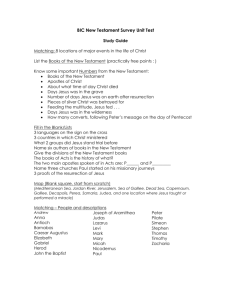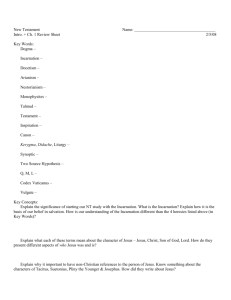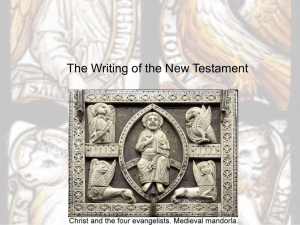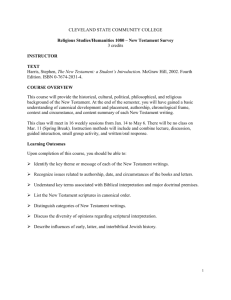Sermon Notes
advertisement
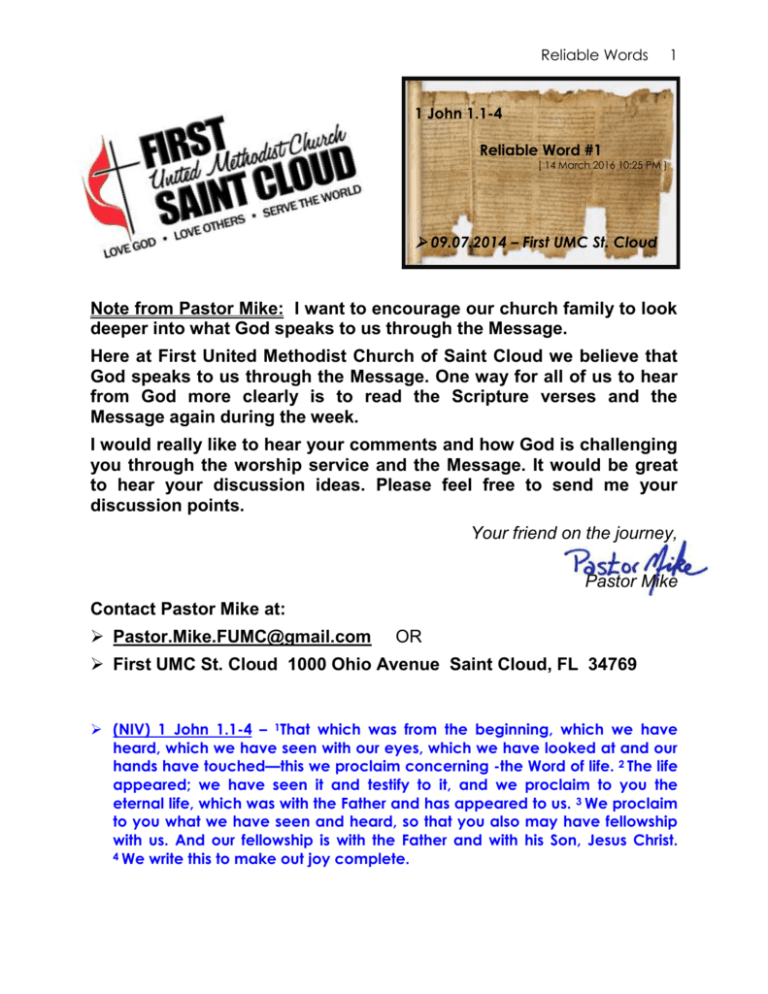
Reliable Words 1 1 John 1.1-4 Reliable Word #1 [ 14 March 2016 10:25 PM ] 09.07.2014 – First UMC St. Cloud Note from Pastor Mike: I want to encourage our church family to look deeper into what God speaks to us through the Message. Here at First United Methodist Church of Saint Cloud we believe that God speaks to us through the Message. One way for all of us to hear from God more clearly is to read the Scripture verses and the Message again during the week. I would really like to hear your comments and how God is challenging you through the worship service and the Message. It would be great to hear your discussion ideas. Please feel free to send me your discussion points. Your friend on the journey, Pastor Mike Contact Pastor Mike at: Pastor.Mike.FUMC@gmail.com OR First UMC St. Cloud 1000 Ohio Avenue Saint Cloud, FL 34769 (NIV) 1 John 1.1-4 – 1That which was from the beginning, which we have heard, which we have seen with our eyes, which we have looked at and our hands have touched—this we proclaim concerning -the Word of life. 2 The life appeared; we have seen it and testify to it, and we proclaim to you the eternal life, which was with the Father and has appeared to us. 3 We proclaim to you what we have seen and heard, so that you also may have fellowship with us. And our fellowship is with the Father and with his Son, Jesus Christ. 4 We write this to make out joy complete. Reliable Words 2 Introduction: Reliable 1. No introduction The “Big Idea” – There is good evidence that words of the Bible are historically reliable. A. In Person Now, we are going to begin with our text in 1 John 1.1-4, where John bases the power of his letter to this ancient Christian church (and to us) on his actually having known Jesus in person. 1. You might imagine, a group of the first Christians, maybe only a few decades after Jesus returns to heaven, gathered together to read a letter from John. John. John who spent three years with Jesus. John who saw the miracles. John who heard Jesus teach about abundant and eternal life. John who witnessed Jesus crucifixion and death. John who saw the empty tomb and then ate a meal with the risen Lord. 2. You might then imagine one of these Christians, maybe a church leader who wants to protect this fledgling church family from being swayed by false teachings, ask, "So, John, why should we listen to your message?" 3. In his letter to this church, John launches right into the answer to this all so important question. To begin with John declare that the subject, the reason, for the letter is that, (NIV) 1 John 1.1a – 1That which was from the beginning John immediately directing our attention to the One, to Jesus, from whom not only does the message of the Church originate but in whom the Church itself exists. The "from the beginning" refers to Christ's birth and more specifically his time of preaching and healing and miracles and meals. 4. Then John makes the claim that is the focus of our conversation this morning. He proclaims (NIV) 1 John 1.1b – which we have heard, which we have seen with our eyes, which we have looked at and our hands have touched. John is almost desperate for us to know that his message comes from the source. Not "a source" he heard about from others, who heard it from others, but "the source" itself, "that which was from the beginning," that he heard, that he saw, that he looked at and that he even touched with his own hands. John knew Jesus in person. Reliable Words 3 a. The verb tense here is significant. "we have heard" and "we have seen" are in are in the perfect tense typically expressing an action in the past which continues to effect the present. The "we have looked at or behold" and "have touched" are in the aorist tense indicating events at a certain point in time. Two claims about Jesus and John's message about Jesus are being made here−1) This life appeared at a specific point in history and 2) the appearance of this life continues to have power in the present. 5. Then John gets to the central point of the introduction and of the whole letter. (NIV) 1 John 1.2 − 2 The life appeared; we have seen it and testify to it, and we proclaim to you the eternal life, which was with the Father and has appeared to us. The eternal life of God became visible and audible and even touchable in Jesus the Christ. John experienced this life when he met Jesus in person. John is now passing that message on but more than simply giving a history lesson, John is proclaiming that this life that he found in the person of Jesus, that same eternal life, can be found in the message (the accounts of eyewitnesses) of Jesus. Through the Bible you and I know and experience the abundant and eternal life of Jesus. B. 1000 Years of Transmission There is good evidence that what we read now reflects what was originally written even after 1000 years of transmission. 1. So, let's begin with the Old Testament which is the Jewish Scriptures but arranged in a slightly different order. There are 39 books (chapters but written at different times and places by various people.) These are the Scriptures that Jesus read when he was on earth as fully God and fully human. These were also accepted by the first Christians as being what we would call "sacred scripture" through which God speaks. a. We are told in the Bible that Moses wrote the first five books of the Bible: Genesis, Exodus, Leviticus, Numbers and Deuteronomy. This is the Pentateuch (five) in the Jewish faith. Moses lived some 1500 years before Jesus was born. The accounts that occurred before Moses life were likely handed down for centuries by word of mouth or in written form. There is some evidence and thought that these books were put in the form we now have them by 500-300 years before Christ. The other books were written and complied in their final forms by about 450 years before Christ. b. There are many reasons to trust that what we read today in the Old Testament has been faithful transmitted to us through the centuries. There is ample archeological finds which align with the accounts in the Old Testament. The obsessive care the scribes of Israel took in copying the words from one scroll to another makes accurate transmission very likely. This morning I want to mention just one. Reliable Words 4 2. The Masoretes were the Jewish scholars who between 500 and 950 years after Christ who compiled the final form to the Old Testament. There were a number of reasons including the destruction of the Temple by the Romans in 70AD and the dispersion of many Jews to other cultures around the world. It become important to preserve these ancient texts which through which God had guided and encouraged the people of Israel for literally centuries. 3. During this time there are two major school (gatherings) of the Masoretes. One in Babylon and the other in Palestine (right in the middle of the world's modern day hot spots.) One of these scholars in Palestine, Moses ben Asher, in the 800 and 900's, produced what is today the standard Hebrew text of the Old Testament. a. So, you say, "The oldest Old Testament we have is only from around 900 years after Christ and is based on a text put together about 100 years after Jesus?" "Right," I say." And right you are to say that is not that long ago considering the time frame of the Old Testament going back to the dawn of our time. 4. Here is the cool part. In March of 1947 a Bedoin shepherd boy named Mohammad goes looking for a lost goat. He throws a rock into a cave in the face of a cliff on the west side of the Dead Sea. [see CAVE IN CLIFF picture] He is surprised to hear not a crashing rock but the shattering of pottery. What he discovers in the cave are stone jars containing scrolls, wrapped in linen cloth. Because the jars [see JARS picture] are so carefully sealed, the scrolls have been wonderfully preserved for over 1900 years! a. In this trove of scrolls is what is known as the "Great Isaiah" scroll, measuring some 24 feet long and 10 inches high. This scroll is dated to about 125 years BEFORE Christ. They belonged to the monk like Jewish community that lived in the desert at Qumran around the Dead Sea [see QUMRAN map] at the same time a Jesus walked our earth. It is likely they hide these sacred documents around 68-70 years after Jesus birth, at the time the Romans were destroying the city of Jerusalem and the Jewish Temple. Reliable Words 5 5. [see INSIDE CAVE picture] Now we have a copy of the Old Testament book of Isaiah (as well as parts of all the other Old Testament books except Esther) dated from around 125 years before Jesus birth to compare to our oldest copy of Isaiah from around 916 years after the birth of Jesus. That is a span of almost thousand years. 6. [see ISAIAH SCROLL picture] Here is what we find. Of the 166 words in Isaiah chapter 53, there are only 17 letters in question. Ten of these letter are simply a matter of spelling, which does not affect the sense. Four more letters are mere stylistic changes. The remaining letters three comprise the word "light," which is added to verse 11 and does not affect the meaning greatly. (Other ancient copies have the word "light" in this place.) a. So, in 166 words of Isaiah chapter 53, only one word of three letters is in question after 1000 years of transmission−and this word does not significantly affect the meaning of the passage. C. God Worked Through Humans I want us then to look at how we received the writing that make up our New Testament and see how the grace of God worked through humans to collect these writing together. 1. I think we see God's grace working to offer us the Bible in the formation of the Cannon. The word "canon" comes from the Greek κανών, meaning "rule" or "measuring stick". 2. From the Apostles to 170 AD: By the end of the 1st century all of the books of the New Testament were in existence. They were, as treasures of given churches, honored as containing the word of Jesus or the teaching of the apostles. In every assembly of Christians from the earliest days the words of Jesus were taught as well as the Old Testament. In each church to which an epistle (letter from an Apostle) was written that epistle was likewise read. Paul asked that his letters be read in this way (1 Thess 5:27; Col 4:16). The widening of the area of the church and the departure of the apostles from earth emphasized increasingly the value of that which the writers of the New Testament left behind them. Reliable Words 6 3. Examination of the testimony to the New Testament in this early time indicates also that there was no initial intention of framing the canonicity of New Testament books. Clement of Rome, in 95 AD, [see CLEMENT OF ROME picture] wrote a letter in the name of the Christians of Rome to those in Corinth. In this letter he uses material found in Matthew and Luke. He has been much influenced by the Epistle to the Hebrews. He knows Romans, Corinthians, and there are found echoes of 1 Timothy, Titus, 1 Peter and Ephesians. Ignatius also quotes 1 Peter and 1 John. a. The Epistles of Ignatius (115 AD) have correspondences with our gospels in several places and incorporate language from nearly all of the Pauline epistles. The Epistle to Polycarp makes large use of Philippians, and besides this cites nine of the other Pauline epistles. 4. Irenaeus [see IRENAEUS picture] (c. 202 year after Christ) was born in Asia Minor, lived and taught in Rome and became afterward bishop of Lyons. He had, therefore, a wide acquaintance with the churches, and was peculiarly competent to speak concerning the general judgment of the Christian world. As a pupil of Polycarp, who was a disciple of John the Disciple, he is connected with the apostles themselves. He makes the New Testament in great part his authority, and often appeals to it; The four Gospels, the Acts, the epistles of Paul, several of the other epistles and the Apocalypse (the Book of Revelation) are to him Scripture in the fullest sense. They are genuine and authoritative, as much so as the Old Testament ever was. a. Clement of Alexandria [see CLEMENT OF ALEXANDRIA picture] (150-215 years after Christ) quotes all four gospels as “Scripture.” b. By the end of the 2nd century the canon of the gospels was settled. The same is true also of the Pauline epistles. Indeed, at this time it may be said that the new canon was known under the designation “The Gospel and the Apostles” in contradistinction to the old as “the Law and the Prophets.” The title “New Testament” appears to have been first used by an unknown writer against Montanism (circa 193 AD). It occurs frequently after this in Origen and later writers. Reliable Words 7 c. In considering all this testimony two facts should have emphasis: [see CHRISTIAN COMMUNITIES map] (1) Its wide extent: Clement and Irenaeus represent parts of Christendom which are widely separated; (2) The relation of these men to those who have gone before them. Their lives together with those before them spanned nearly the whole time from the apostles. They but voiced the judgment which silently, gradually had been selecting the “Scripture” which they freely and fully acknowledged and to which they made appeal. 5. Eusebius, [see EUSEBIUS picture] in the early part of the 4th century (270-340 AD), bishop of Caesarea before 315, sets before us in his Church History (III, chapters iii-xxv) his estimate of the canon in his time. He does not of course use the word canon, but he “conducts an historical inquiry into the belief and practice of earlier generations.” He lived through the last great persecution in the early part of the 4th century, when not only places of worship were razed to the ground, but also the sacred Scriptures were in the public market-places consigned to the flames (Historia Ecclesiastica, VIII, 2). It was, therefore, no idle question what book a loyal Christian must stand for as his Scripture. The question of the canon had an earnest, practical significance. a. Despite some obscurity and apparent contradictions, his classification of the New Testament books was as follows: (1) His criteria for each of the acknowledged books was authenticity and apostolicity: the Gospels, Acts, and Paul’s epistles, including Hebrews. (2) The disputed books which had obtained only partial recognition: James, Jude, 2 Peter and 2 John. About the Apocalypse also he was not sure. 6. Athanasius [see ATHANASIUS picture] in one of his pastoral letters in connection with the publishing of the ecclesiastical calendar gives a list of the books comprising Scripture, and in the New Testament portion are included all the 27 books which we now recognize. “These are the wells of salvation,” he writes, “so that he who thirsts may be satisfied with the sayings in these. Let no one add to these. Let nothing be taken away.” 7. For a considerable time the Apocalypse was not accepted in the Palestinian or Syrian churches. The Syrian church did not accept all of the other non-Paul epistles until much later. Reliable Words 8 8. The Council of Carthage in 397, [see CARTHAGE map] in connection with its decree “that aside from the canonical Scriptures nothing is to be read in church under the name of Divine Scriptures,” gives a list of the books of the New Testament. After this fashion there was an endeavor to secure unanimity, while at the same time differences of judgment and practice continued. The publication of the Vulgate (Jerome’s Latin Bible, 390405 A.D.) virtually determined the matter. 9. In conclusion let it be noted how much God worked through humans in the whole process of forming our New Testament. No one would wish to dispute a providential overruling of it all. Also it is well to bear in mind that all the books have not the same clear title to their places in the canon as far as the history of their attestation is concerned. Clear and full and unanimous, however, has been the judgment from the beginning upon the Gospels, the Acts, the Pauline epistles, 1 Peter and 1 John. D. Brings Us Into Fellowship So, we see that the early church discovered that the words for those who knew Jesus personally or were close to who knew Jesus personally brought them into fellowship with Jesus and with the church. And they still bring us into that same fellowship. 1. John explains what he intends to happen in the reading of his letter. (NIV) 1 John 1.1-4 – 3 We proclaim to you what we have seen and heard, so that you also may have fellowship with us. And our fellowship is with the Father and with his Son, Jesus Christ. 4 We write this to make our joy complete. Now, let's work backwards. You might suspect that the writer of a letter would say something like, "It would be so much more meaningful it I could say this to you in person." Yet, John says simply that to write this for his friends in this church family to read makes his joy complete. To read this letter is enough, more than enough. 2. Enough of what? Enough to have fellowship. You see, the early church Christians did not pick and choose the letters they liked. They came to hold as sacred Scripture letters whose words brought them in contact with the person of Jesus the Christ. Letters that did not were read less and lost to time. This is the same with the Old Testament. a. The Greek word here is koinonia which speaks of a partnership in a venture or joint ownership in a concern. b. So in reading this letter, in reading the Bible, there is enough for us to have fellowship, a joint venture together with God, that is, to enter the life-ofGod. Reliable Words 9 c. Also, fellowships with John, who knows Jesus in person, but also with others believer throughout the generations, in a joint ownership of the Christian faith and the work of the church. “Action Point” – Trust the words of the Bible to bring you into the life of God and into the life and work of the church.
